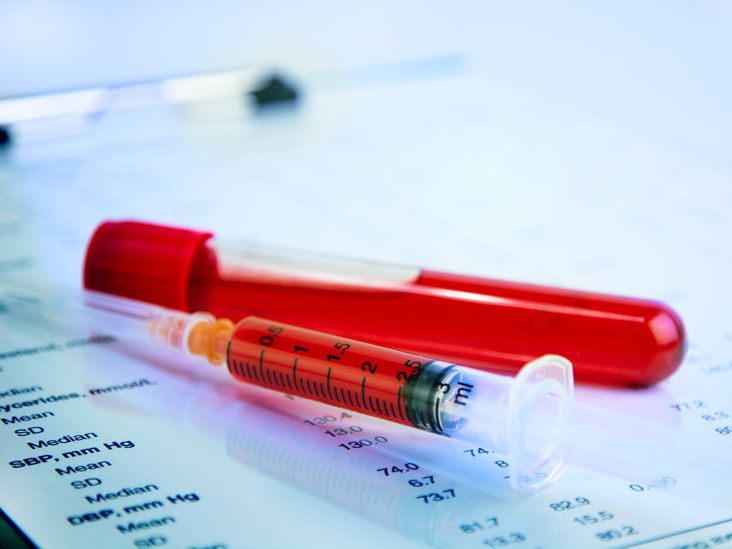Play all audios:
What is a haptoglobin test? A haptoglobin test measures the amount of haptoglobin in your blood. Haptoglobin is a protein produced by your liver. It binds with hemoglobin, which is a protein
found in red blood cells. Red blood cells have the important role of transporting oxygen from the lungs to the heart and the rest of the body. They’re produced by the bone marrow and are
eventually broken down in the liver and spleen. When red blood cells are destroyed, they release hemoglobin. The released hemoglobin is called “free hemoglobin.” Haptoglobin attaches to the
free hemoglobin to create a haptoglobin-hemoglobin complex. This complex travels to the liver, where it’s removed from the body. Normally, the body maintains the balance between red blood
cell destruction and production. When this process is disrupted, however, red blood cells may be eliminated at a faster rate than they’re made. This causes haptoglobin levels to drop, as the
protein is being eliminated from the body faster than the liver can make it. Increased red blood cell destruction may occur as a result of: * inherited conditions that cause abnormalities
in the size or shape of red blood cells, such as hereditary spherocytosis * spleen disorders * cirrhosis, or severe scarring of the liver * myelofibrosis, or scarring of the bone marrow
These conditions can lead to the development of a form of anemia called hemolytic anemia. Hemolytic anemia occurs when the bone marrow can’t produce red blood cells as quickly as they’re
being destroyed. The inadequate supply of red blood cells means that the body may not get enough oxygen. A haptoglobin test can detect whether you have hemolytic anemia or another type of
anemia. It may also help determine the exact cause of increased red blood cell destruction. Why is a haptoglobin test performed? Your doctor may decide to run a haptoglobin test if you’re
experiencing symptoms of hemolytic anemia. These symptoms can include: * severe fatigue * pale skin * cold hands and feet * jaundice, or yellowing of the skin and the whites of the eyes *
upper abdominal pain * dizziness * lightheadedness * shortness of breath * arrhythmia, or an abnormal heartbeat As noted above, people with hemolytic anemia may experience abdominal pain and
jaundice. Jaundice occurs as a result of high bilirubin levels. Bilirubin is a yellow pigment that forms when red blood cells are broken down and eliminated from the body. When red blood
cells are destroyed at an increased rate, it can lead to a buildup of bilirubin in the blood. This causes the skin or eyes to appear yellow. Higher-than-normal levels of bilirubin can also
result in gallstones, which are hard deposits that form in the gallbladder. The haptoglobin test can confirm a hemolytic anemia diagnosis and help determine the underlying cause. How do I
prepare for a haptoglobin test? A haptoglobin test doesn’t require any special preparation. It’s important to discuss your medical history and medication use with your doctor so they can
interpret your haptoglobin test results more accurately. The results can be affected by various underlying medical conditions, such as rheumatoid arthritis, ulcerative colitis, and chronic
liver disease. They may also be impacted by the use of certain medications, including corticosteroids and birth control pills. How is a haptoglobin test performed? A haptoglobin test
involves taking a small sample of blood. It’s performed at a doctor’s office or a medical laboratory. A healthcare provider will perform the procedure. In most cases, the blood will be drawn
from a vein inside of your elbow. During this test, the following will occur: * Your healthcare provider will first clean the area with alcohol or another sterilizing solution. * They’ll
then tie an elastic band around your arm to make the veins swell with blood. Once they find a vein, they’ll insert a needle into your vein to draw blood. The blood will be collected in a
small tube or vial attached to the needle. * After they’ve drawn enough blood, they’ll remove the needle and cover the puncture site with a bandage to stop any bleeding. A haptoglobin blood
test only takes a few minutes to complete. You should get your results within a few days. What do my haptoglobin test results mean? A normal haptoglobin level falls between 45 and 200
milligrams of haptoglobin per deciliter of blood. There can also be minor variations depending on the hospital or diagnostic facility. If you have a level that’s lower than 45 milligrams of
haptoglobin per deciliter of blood, it’s likely that your red blood cells are being destroyed more quickly than they’re being made. If your level is below the normal range, you may have
hemolytic anemia or some other form of anemia. If your haptoglobin level exceeds 200 milligrams per deciliter of blood, this may be a sign of acute rheumatic fever, ulcerative colitis, or a
heart attack. Test results can vary depending on the laboratory that analyzed your blood sample. Your doctor will discuss your individual results with you and explain what they mean.
Depending on the results, more tests may need to be performed.

